Sunset-colored light therapy triggers your body's natural sleep-wake cycle by mimicking the day's end. When you're exposed to orange and red hues in the evening, your brain starts producing melatonin, the sleep hormone, while reducing cortisol levels that keep you alert. You'll notice your stress levels dropping as these warm colors naturally calm your mind and prepare your body for rest. Evening light exposure through sunset viewing or specialized LED devices can stabilize your mood, enhance sleep quality, and promote deep relaxation. Discover how this ancient natural phenomenon holds the key to transforming your nightly routine.
The Science Behind Sunset Colors
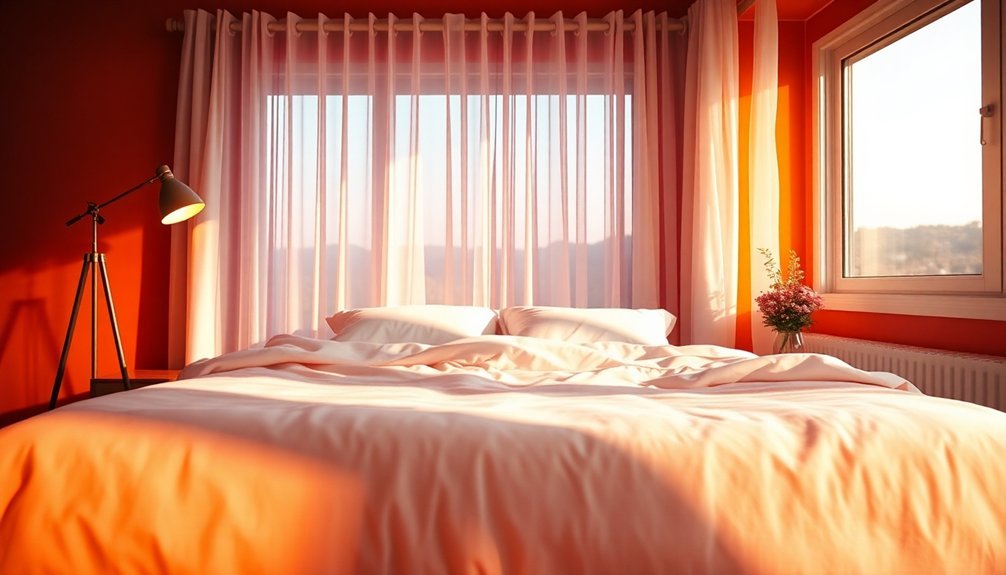
Light's journey through our atmosphere creates the mesmerizing colors of sunset. When sunlight travels through the atmosphere at a low angle during sunset, it must pass through more air than during midday, triggering a fascinating process called scattering.
You'll notice that different wavelengths of light behave distinctly during this journey. Blue and violet light, which have shorter wavelengths, scatter more readily when they collide with atmospheric molecules. This leaves the longer wavelengths – red, orange, and yellow – to continue their path to your eyes, painting the sky in warm hues. Red light penetrates furthest through the atmosphere due to its long wavelength.
The colors you see during sunset depend heavily on atmospheric conditions. When there's more dust, smoke, or water droplets in the air, you'll witness more intense reds and oranges because these particles increase the scattering of blue light.
Clouds can add another dimension to the display, creating pink and purple hues as sunlight interacts with water droplets.
This selective scattering, known as Rayleigh scattering, explains why you'll see a blue sky during the day but warmer colors at sunset. The phenomenon is predictable and varies based on atmospheric composition and weather conditions.
Natural Light and Sleep Patterns
Natural daylight plays a fundamental role in the regulation of your sleep patterns. Your body's internal clock, or circadian pacemaker, relies heavily on the sun's natural light-dark cycle to maintain proper timing.
When you're exposed to outdoor light, which is typically ten times brighter than indoor lighting, you're helping your body maintain strong synchronization with the day. The unique blue to yellow ratio at sunrise provides a powerful signal to wake up your body.
Your exposure to different types of light throughout the day creates a precise rhythm that affects your sleep quality. Here's how natural light influences your sleep-wake cycle:
- Morning light exposure can shift your internal clock up to one hour earlier, making it easier to wake up naturally
- Midday bright light boosts your alertness and helps you sleep better at night
- Evening light exposure can delay your sleep cycle by up to two hours
- Natural darkness triggers melatonin production, preparing your body for sleep
When you don't get enough natural light or expose yourself to artificial light at the wrong times, you're risking disrupted sleep patterns. This disruption can lead to various health issues, including metabolic problems, weight gain, and mood disorders.
Healing Properties of Evening Light
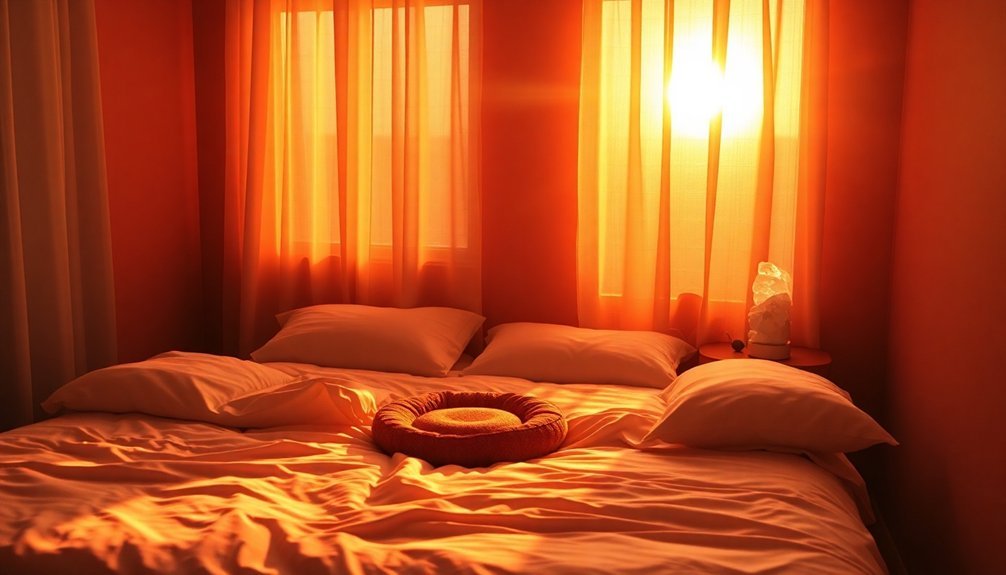
You'll discover powerful healing benefits when you expose yourself to natural sunset colors, as these wavelengths work harmoniously with your body's sleep-wake cycle.
The orange and red hues of evening light naturally calm your mind and reduce stress levels, creating an ideal environment for winding down. Regular sunset viewing can lower cortisol levels up to 21% within an hour.
As dusk approaches, your circadian rhythm responds to these warmer wavelengths by initiating melatonin production, helping you prepare for a restful night's sleep.
Natural Wavelength Sleep Benefits
Evening's gentle wavelengths hold remarkable healing properties that can transform your sleep quality and regulate your body's natural rhythms. When you expose yourself to natural evening light or therapeutic red wavelengths, you'll help your body prepare for restful sleep while maintaining a healthy circadian rhythm.
Your body responds particularly well to specific light wavelengths at different times. Unlike blue light sources, red light actually promotes melatonin production in your body. Here's how you can maximize these benefits:
- Start your day with natural sunlight exposure to set your internal clock and boost your cognitive function
- Use red light therapy in the afternoon to improve alertness and prepare for evening wind-down
- Gradually reduce exposure to artificial light sources as evening approaches to support melatonin production
- Incorporate sunset-colored light therapy during fall and winter months to maintain sleep-wake balance
Natural wavelengths work effectively because they mirror your body's evolutionary adaptation to the sun's daily cycle.
You'll find that consistent exposure to appropriate light wavelengths can improve your mood, reduce inflammation, and enhance overall sleep quality.
While evening light therapy shows promise, it's most effective when combined with proper morning light exposure to maintain your natural circadian rhythm.
Orange Light Calms Mind
Remarkable healing properties emerge when orange wavelengths of light interact with your brain's cognitive functions. When you're exposed to orange light, your brain's melanopsin receptors become more sensitive, triggering a cascade of cognitive benefits that help prepare you for rest. Studies show that exposure to orange light (589 nm) enhances frontal activity in regions linked to alertness and cognitive processing.
| Evening Effects | Brain Response |
|---|---|
| Alertness Control | Your prefrontal cortex activity adjusts, reducing mental hyperactivity |
| Memory Processing | Your brain consolidates daily information more effectively |
| Circadian Timing | Your internal clock aligns with natural sunset patterns |
You'll notice these calming effects particularly during evening hours, when your brain needs to shift from daytime alertness to nighttime rest. The orange wavelengths work with your body's natural photic memory system, creating a therapeutic environment that can reduce the need for sleep medications. If you're dealing with mental health challenges, you'll find that orange light exposure can help stabilize mood swings and decrease manic symptoms. Modern research shows that incorporating orange light into your evening routine isn't just soothing – it's a scientifically-backed approach to improving your mental well-being and sleep quality.
Dusk's Circadian Reset Power
Natural sunset shifts hold powerful influence over your body's internal clock, serving as a biological reset button for your circadian rhythms. When you expose yourself to evening light during the two hours before and after your usual bedtime, you can shift your internal clock by up to two hours later each day. This makes strategic exposure to dusk-like lighting a powerful tool for regulating your sleep-wake cycle.
The timing and quality of evening light exposure directly impacts your body's natural rhythms in several key ways:
- Evening light exposure delays melatonin production, which can help you adjust your sleep schedule when needed
- The vibrant colors of sunset naturally reset your circadian system, mimicking Earth's light-dark cycle
- Proper evening light exposure can reduce inflammation and improve overall sleep quality
- Light therapy using sunset-like colors can help stabilize mood and address seasonal affective disorder
You'll want to avoid bright light two hours before bedtime to fall asleep more easily. Instead, opt for dimmer, warmer lighting that mimics natural sunset, allowing your body to move smoothly into its sleep phase. Research shows that using red or near infrared light in the evening can enhance mitochondrial function and cellular energy production, supporting your body's natural healing processes while you rest.
Melatonin Production After Sunset
The human body's melatonin production kicks into high gear as the sun dips below the horizon, triggered by the rich red and orange wavelengths of sunset. Your pineal gland and cellular mitochondria begin releasing this essential sleep hormone, preparing your body for rest as darkness approaches.
If you're following nature's rhythm, you'll notice your alertness gradually declining as these sunset colors signal your internal clock. Taking a warm relaxing bath at sunset can help support your body's natural wind-down process.
You'll get the most benefit from this natural process when you limit artificial light exposure in the evening. Your body responds particularly well to alternating blue and orange light patterns, which can advance your melatonin production more effectively than standard lighting.
If you're over 40, you'll need to be especially mindful of your evening light exposure, as your natural melatonin levels have already started to decline with age.
To optimize your melatonin production, you can use LED devices that mimic sunset colors. They're particularly helpful if you're dealing with seasonal affective disorder or other circadian rhythm disruptions.
Evening Relaxation Through Nature

Evening walks amid nature's twilight display can transform your bedtime routine into a therapeutic experience. When you immerse yourself in the warm hues of sunset, you'll notice your stress levels dropping as nature's visual therapy takes effect.
The shift from daylight to dusk creates a natural signal for your body to begin unwinding, while the cleaner evening air supports your respiratory health. Night sounds and crickets create a soothing background that promotes deep relaxation.
You'll find that spending time outdoors during these golden hours offers multiple benefits for your physical and mental well-being:
- The evening's cooler temperatures make it more comfortable to engage in light physical activity, improving your cardiovascular health
- Natural sunset colors stimulate the production of feel-good hormones while reducing cortisol levels
- The magical quality of twilight enhances mindfulness and mental clarity, helping you process the day's events
- Evening exposure to natural light helps regulate your circadian rhythm, leading to better sleep quality
Your evening nature routine doesn't just calm your mind—it creates a meaningful shift between day and night, fostering a sense of continuity that carries you peacefully into your sleep schedule.
Mindful Sunset Observation Benefits
Mindful sunset observation delivers four powerful psychological benefits that can transform your evening routine. When you take time to watch the sun dip below the horizon, you'll experience a natural boost in dopamine, your brain's feel-good chemical, which enhances your overall mood and sense of well-being.
By focusing on the changing colors of the sky, you'll notice your mind becoming clearer and more present. This mindfulness practice helps reduce mental clutter and promotes self-reflection, allowing you to process your day's experiences more effectively.
You'll find yourself naturally shifting into a state of gratitude as you connect with nature's daily spectacle.
The practice also works wonders for your sleep preparation. As you observe the dimming light, your body naturally aligns with its circadian rhythm, making it easier to fall asleep later.
The calming effect reduces cortisol levels and eases muscle tension, creating an ideal shift from daytime activity to nighttime rest.
You'll discover that regular sunset viewing becomes a form of natural therapy, reducing anxiety while improving your emotional well-being through consistent exposure to this peaceful evening ritual.
Creating Your Sunset Viewing Ritual
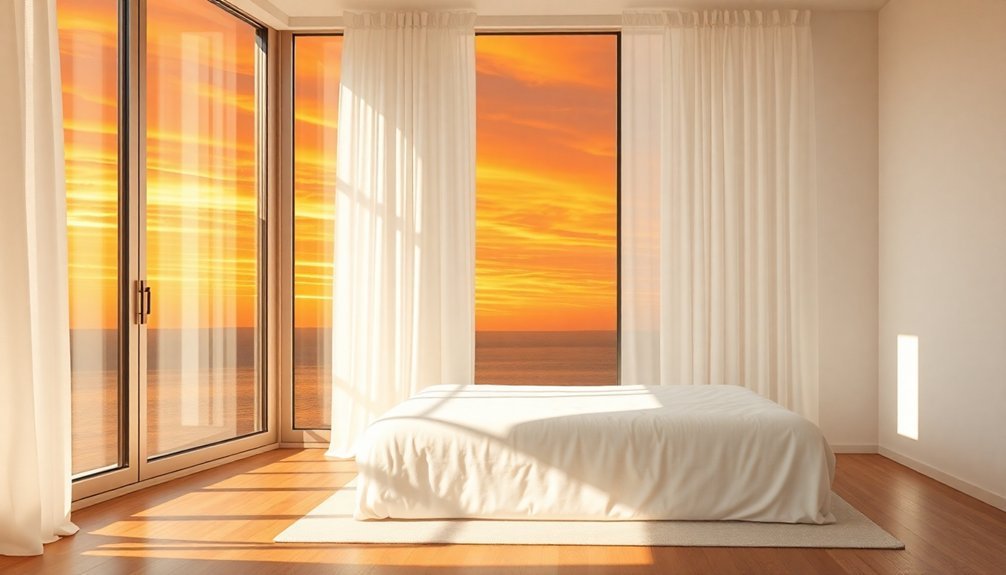
You'll want to start your sunset ritual by finding a spot that offers an uninterrupted view of the horizon, whether it's a peaceful hilltop, an open beach, or your own backyard patio.
To make this practice sustainable, you'll need to set aside a specific time each day that aligns with the sunset schedule in your area, ensuring you can consistently show up for this mindful experience.
Creating a dedicated space with comfortable seating, cozy blankets, and perhaps a warm beverage will help you fully embrace this daily moment of tranquility.
Selecting Your Sunset Spot
Creating a meaningful sunset ritual begins with finding the perfect viewing spot that speaks to both your practical needs and emotional well-being. Your chosen location should offer an unobstructed view of the horizon while providing a sense of tranquility and comfort for regular visits. You'll want to prioritize spots that minimize artificial lighting and allow you to fully immerse yourself in nature's display.
When selecting your ideal sunset viewing location, consider these essential factors:
- Accessibility and safety – Choose a spot you can easily reach year-round and that provides secure viewing conditions regardless of weather.
- Natural ambiance – Look for locations that offer nature's soundtrack, like gentle waves or rustling leaves, while limiting urban noise.
- Comfort features – Guarantee there's enough space to set up your comfort items, such as blankets, cushions, or a favorite chair.
- Seasonal adaptability – Select a location that works across different seasons and weather patterns.
Remember to prepare your chosen spot by bringing necessary comfort items and creating a distraction-free environment. You'll want to disconnect from digital devices and perhaps incorporate mindfulness tools like journals or aromatherapy to enhance your sunset experience.
Prepare your chosen spot by bringing necessary comfort items and creating a distraction-free environment. You'll want to disconnect from digital devices and perhaps incorporate mindfulness tools like journals or aromatherapy to enhance your sunset experience.
Time and Space Planning
With your ideal sunset spot secured, the next step involves organizing both your time and space to maximize the therapeutic benefits of your evening ritual. You'll want to plan for approximately 90 minutes before sunset, giving yourself ample time to witness the complete transformation from daylight to dusk.
Creating a sacred viewing space requires careful attention to comfort and ambiance. Bring essentials like comfortable seating, blankets, and bug spray, while ensuring you've got an unobstructed view of the western sky.
You'll enhance your experience by minimizing distractions and incorporating natural elements that engage your senses.
To make this ritual sustainable, you'll need to practice flexibility and consistency. Check local sunset times, which vary by location and season, and maintain a 7-day window of alternative dates for unfavorable weather conditions.
Consider using minimal technology, perhaps only for timing purposes, and focus instead on mindful breathing and sensory awareness.
Remember to adapt your ritual as needed while maintaining its core elements. Whether you have 15 minutes or a full hour, you can still capture the therapeutic benefits by staying present and engaging fully with nature's daily farewell.
Sleep Quality and Natural Light
Natural light plays a pivotal role in regulating your sleep-wake cycle and overall sleep quality. When you expose yourself to bright daylight, especially during morning and midday hours, you're helping your body maintain its natural circadian rhythm.
This exposure to natural light, which can reach up to 10,000 lux, substantially outperforms artificial lighting in promoting healthy sleep patterns.
During winter months or in locations with limited natural light, you'll need to be more intentional about light exposure. If you don't get enough daylight, you might find yourself staying up later and sleeping in, disrupting your regular sleep schedule. This disruption becomes particularly noticeable in higher latitudes where seasonal light variations are more extreme.
To optimize your sleep quality through natural light management:
- Get outside during peak daylight hours, especially in the morning
- Position your workspace near windows to maximize natural light exposure
- Reduce artificial blue light from devices in the evening hours
- Use sunset-colored lighting after dark to maintain healthy melatonin production
These practices help align your internal clock with natural light cycles, promoting better sleep quality and more consistent sleep patterns.
Transformative Power of Red Light
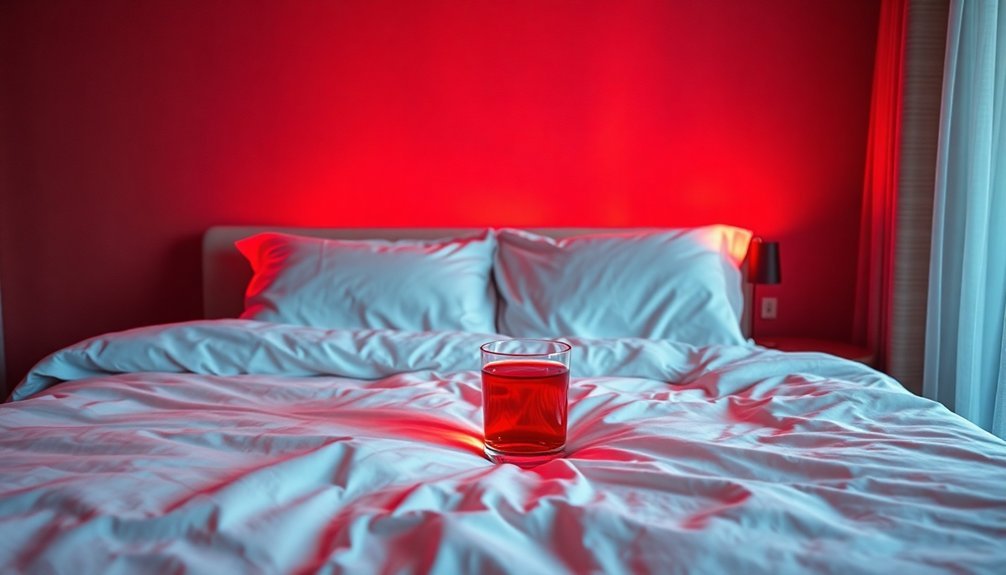
You'll find remarkable sleep benefits when incorporating red light therapy into your bedtime routine, as it naturally stimulates melatonin production without disrupting your circadian rhythm.
Unlike blue light, which can suppress sleep hormones, red light wavelengths between 600-1000 nm work with your body's natural processes to promote relaxation and deeper sleep.
The therapy's ability to reduce cortisol levels while boosting serotonin production makes it an effective, natural solution for improving your sleep quality and maintaining a healthy sleep-wake cycle.
Red Light Sleep Benefits
Red light therapy has emerged as a game-changing solution for people struggling with sleep issues, offering a natural way to reset your body's internal clock and improve overall sleep quality. Unlike harsh blue light that disrupts your sleep patterns, red light works harmoniously with your body's natural circadian rhythms, supporting melatonin production and creating an ideal environment for restful sleep.
When you incorporate red light therapy into your bedtime routine, you'll experience these transformative benefits:
- Your stress and anxiety levels decrease naturally as the therapy boosts endorphin production and regulates cortisol, helping you feel more relaxed before bed.
- You'll notice reduced pain and inflammation, making it easier to find a comfortable sleeping position and maintain uninterrupted sleep.
- Your body's internal clock synchronizes more effectively, helping you fall asleep faster and maintain a consistent sleep schedule.
- Your overall sleep quality improves without the risk of medication side effects, as red light therapy is non-invasive and doesn't suppress melatonin production.
Clinical evidence supports these benefits, making red light therapy a safe, effective solution for enhancing your sleep quality and maintaining healthy sleep patterns.
Natural Melatonin Production Enhancement
Understanding how to boost your body's melatonin production naturally can revolutionize your sleep quality without relying on supplements. You'll find powerful melatonin-rich foods like pistachios, tart cherries, and oats can substantially enhance your body's natural sleep-inducing processes.
Adding mushrooms and whole grain rice to your evening meals can further support your sleep cycle through their concentrated melatonin content.
Your exposure to different light wavelengths plays a vital role in melatonin production. You'll get the most benefit from alternating blue-orange light therapy, which can advance your melatonin production by about 80 minutes – far more effective than traditional white light exposure. This mimics the natural sunset colors your brain responds to for initiating sleep.
You'll want to avoid factors that can disrupt your natural melatonin production, such as consuming caffeine, green tea, or sugary foods close to bedtime. Instead, create an environment that aligns with your circadian rhythm by dimming lights and introducing sunset-colored lighting in the evening.
This approach works with your body's natural processes, helping you achieve more restful sleep without artificial interventions.
Evening Light Exposure Guidelines
Managing your evening light exposure plays a crucial role in maintaining healthy sleep patterns. The light you're exposed to during evening hours can either support or disrupt your natural melatonin production, directly impacting your ability to fall asleep and maintain quality rest.
To protect your circadian rhythms and optimize your sleep, you'll want to follow these evidence-based guidelines:
- Dim your home's lighting approximately 3 hours before bedtime, and switch to warmer, sunset-colored light sources that won't suppress melatonin production.
- Avoid bright screens and blue light-emitting devices in the hours leading up to sleep, or use blue-light blocking glasses if screen use is unavoidable.
- Install red-tinted night lights instead of bright white ones for any necessary nighttime illumination.
- Create a completely dark sleep environment in your bedroom to support your body's natural sleep-wake cycle.
If you're working night shifts, you'll need to adjust these guidelines by increasing light exposure during the first half of your shift to stay alert, then reducing it during the second half to prepare your body for post-shift sleep.
Consistent application of these principles will help regulate your circadian rhythms and improve your sleep quality.
Developing Healthy Sleep Habits
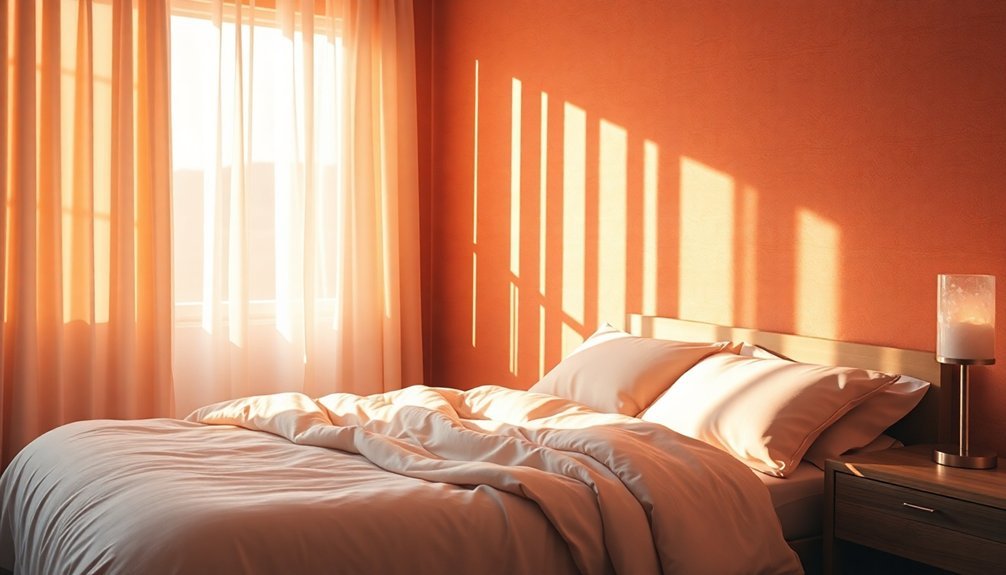
Building on proper light exposure habits, developing a thorough set of healthy sleep practices will transform your nightly rest. Start by establishing a consistent sleep schedule – go to bed and wake up at the same time every day, even on weekends. You'll need to allow for 7-8 hours of quality sleep each night to maintain vital health.
Create a calming pre-sleep routine that signals your body it's time to wind down. Avoid screens, bright lights, and stimulating activities in the evening. Instead, opt for relaxing activities like reading or listening to soft music.
You'll want to dim the lights gradually as bedtime approaches.
Your bedroom environment plays an essential role in sleep quality. Keep your room cool, dark, and quiet. Install blackout curtains, use white noise if needed, and guarantee your bedroom is solely dedicated to sleep and intimacy. Don't use it as a home office or entertainment space.
Finally, make lifestyle choices that support good sleep. Exercise regularly but not close to bedtime, avoid large meals before sleeping, and eliminate caffeine and alcohol in the evening. These habits will help regulate your body's natural sleep-wake cycle.
Frequently Asked Questions
Can Watching Sunsets Through Windows Provide the Same Sleep Benefits?
Yes, you'll get similar sleep benefits watching sunsets through windows. You're still receiving the vital visual cues that trigger melatonin release and regulate your circadian rhythm, helping improve your sleep quality naturally.
How Long Should I Watch the Sunset to Experience Therapeutic Effects?
You'll benefit from just 10 minutes of sunset watching, though there's no strict time limit. Making it a consistent daily practice matters more than the duration. Even brief viewings can improve your mental well-being.
Are Artificial Sunset Lamps Effective Alternatives During Cloudy or Winter Days?
Yes, artificial sunset lamps are effective alternatives. You'll benefit from their blue-orange LED technology, which advances melatonin production by 80 minutes and helps regulate your circadian rhythm during cloudy or dark winter days.
Does Watching Sunset Videos on Screens Offer Similar Circadian Rhythm Benefits?
No, watching sunset videos won't provide the same circadian benefits as natural sunsets. Your screens lack the specific light wavelengths that trigger melatonin production and can actually disrupt your sleep-wake cycle instead.
Can Sunset Viewing Help With Jet Lag When Traveling Across Time Zones?
Yes, watching real sunsets can help reset your circadian rhythm when traveling. You'll adjust faster to your new time zone by timing your sunset viewing with your destination's natural light-dark cycle.
In Summary
You'll find that incorporating sunset-colored light therapy into your bedtime routine can revolutionize your sleep quality. When you embrace these natural evening hues, you're working with your body's biological rhythms rather than against them. Start small by dimming lights and using warmer colors in the hours before bed – you'll soon notice improved relaxation, better sleep, and more energized mornings.

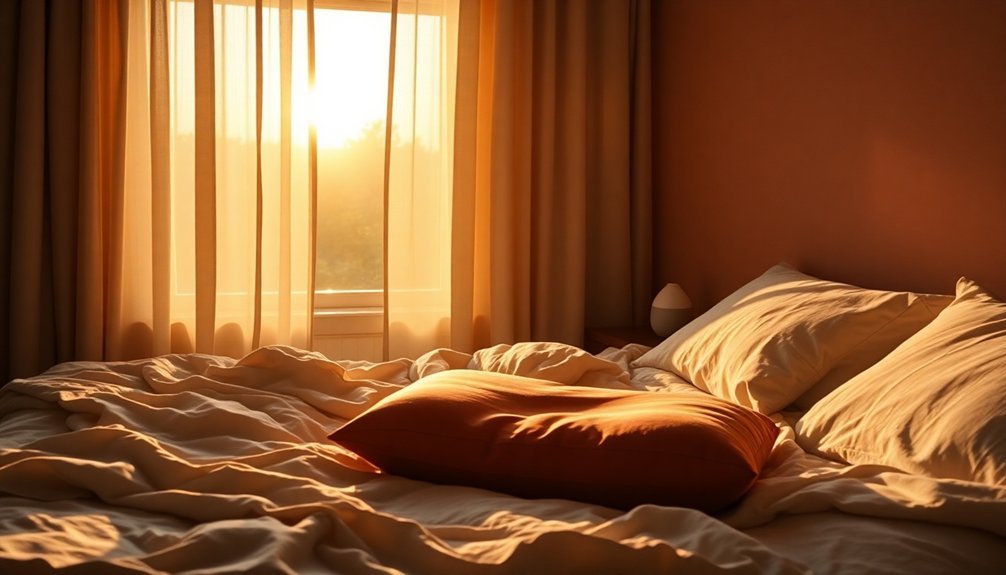



Leave a Reply